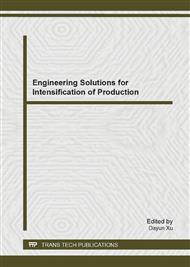[1]
Smaoui M., Brun X., Thomasset D., A study on tracking position control of an electropneumatic system using backstepping design, Control. Engineering. Practice, Vol. 14, Issue 8 (2006), pp.923-933.
DOI: 10.1016/j.conengprac.2005.05.003
Google Scholar
[2]
Khayati K., Bigras P, Dessaint L. -A, LuGre model-based friction compensation and positioning control for a pneumatic actuator using multi-objective output-feedback control via LMI optimization, Mechatronics, vol. 19 (2009), p.535–547.
DOI: 10.1016/j.mechatronics.2008.12.006
Google Scholar
[3]
Perondi E. A., Suzuki R. M., Sobczyk M. R., Feedback Linearization Control Applied to a Pneumatic Actuator System. Proceedings of the 18th Brazilian Conference on Automatics (2010) p.2473.
Google Scholar
[4]
Canudas de Wit, C., Olsson, H., Astrom, K.J., Lischinsky, P., A New Model for Control Systems with Friction, IEEE Trans. on Automatic Control, Vol. 40, n. 3 (1995), pp.419-425.
DOI: 10.1109/9.376053
Google Scholar
[5]
Bone, G. Ning, S., Experimental comparison of position tracking control algorithms for pneumatic cylinder actuators, IEEE/ASME Trans. Mechatronics, Vol. 12 (2007), pp.557-561.
DOI: 10.1109/tmech.2007.905718
Google Scholar
[6]
Kaitwanidvilai S., Parnichkun M., Force control in a pneumatic system using hybrid adaptive neuro-fuzzy model reference control, Mechatronics Vol. 15 Issue 1 (2005), pp.23-41.
DOI: 10.1016/j.mechatronics.2004.07.003
Google Scholar
[7]
Sobczyk M. R., Perondi, E. A., Variable Structure Cascade Control of a Pneumatic Positioning System, ABCM Symposium Series in Mechatronics, Vol. 2, (2006), pp.27-34.
Google Scholar
[8]
Sobczyk, M.R., Perondi, E.A. ; Cunha, M.A.B., A continuous extension of the LuGre friction model with application to the control of a pneumatic servo positioner, Proceedings of the 51st IEEE Conference on Decision and Control (2012), pp.3544-3550.
DOI: 10.1109/cdc.2012.6426406
Google Scholar
[9]
Sobczyk M. R., Perondi, E. A., Cunha, M.A.B., A continuous approximation of the LuGre friction model, ABCM Symposium Series in Mechatronics, Vol. 4, (2010), pp.218-228.
Google Scholar
[10]
Zeng, H., Sepehri, N. Adaptive Backstepping Control of Hydraulic Manipulators with Friction Compensation Using Lugre Model, Proceedings of the American Control Conference (2006).
DOI: 10.1109/acc.2006.1657204
Google Scholar
[11]
Freidovich L., Robertsson A., Shiriaev A., Johansson R., Lugre model-based friction compensation, IEEE Trans. on Control Systems Technology, vol. 18, no. 1 (2010), p.194 –200.
DOI: 10.1109/tcst.2008.2010501
Google Scholar
[12]
Khalil H. K., Nonlinear Systems, 3rd Ed., Prentice-Hall (2002).
Google Scholar


